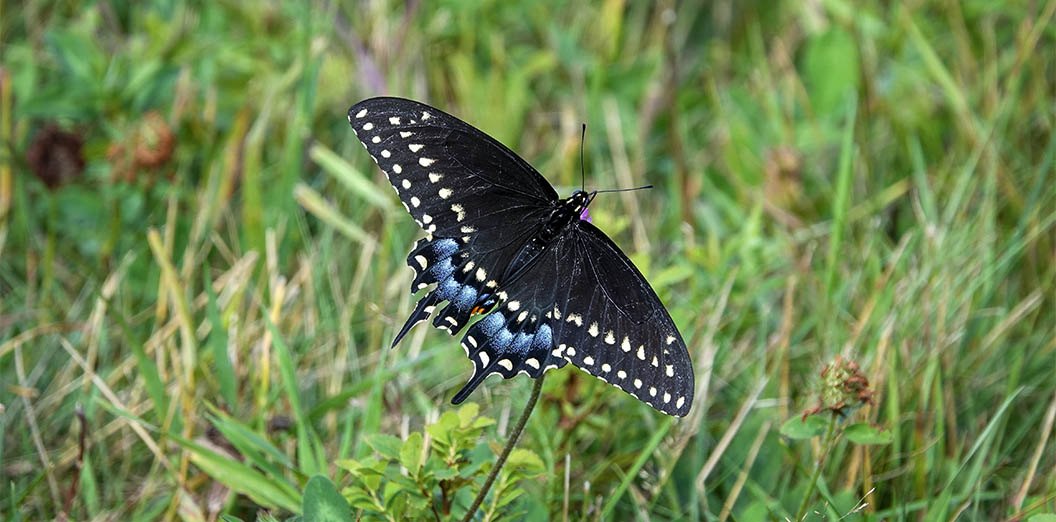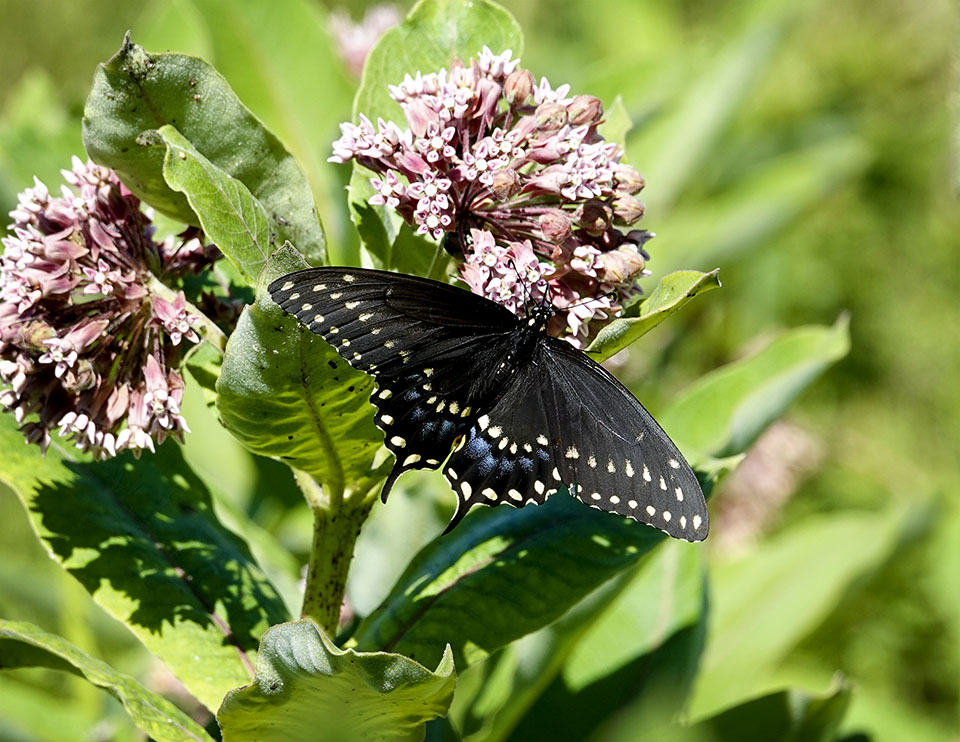Butterflies of the Adirondacks:
Black Swallowtail (Papilio polyxenes)

The Black Swallowtail (Papilio polyxenes) is a relatively large butterfly that may be seen in the Adirondack Mountains in upstate New York from late spring through early fall. It is also known as the Eastern Black Swallowtail, the American Swallowtail, and the Parsnip Swallowtail. [1] [2]
This butterfly is a member of the family Papilionidae (Swallowtails), named for the tail-like projections on their hind wings, which resemble the tails of swallows. [3] [4] The Black Swallowtail is the state butterfly of Oklahoma. The species name (polyxenes) is named after Polyxena, a character in the Homeric myth Iliad. [5]
Black Swallowtail: Identification

The upper surface of the wings of the Black Swallowtail is black with a row of submarginal cream-yellow spots. [6] The Black Swallowtail has distinct orange eye-spots with a black spot in the center on the hind wings close to the tail.[7]
Seen from above, the female has a row of yellow spots and an iridescent blue band, while the male has a yellow band near the edge of his wings. [8] [9] The abdomen has a longitudinal row of yellow spots. The average wing span is 3.2 inches. [10]
Black Swallowtail: Life History
At low temperatures, Black Swallowtails perch close to the ground with their wings spread. At higher temperatures, they perch higher and fly more frequently. Courtship and mating occur from midday to late afternoon.[11]
The eggs are yellow. [12] The mature caterpillar is up to 2 inches long, sporting white to green with black bands dotted with orange or yellow spots on each segment. [13] [14] The larva of this insect feeds on many plants in the parsley family, including Queen Anne's Lace, carrot celery, and dill. [15] [16] [17]
The adult feeds on nectar from flowers such as red clover, milkweed, and thistles.[17] [19] [20] The adults flutter their wings while taking nectar, possibly for balance. [21] [22] Black Swallowtails lives from six to fourteen days. [23]
Black Swallowtail: Habitat and Range
From an ecological standpoint, the Black Swallowtail is a generalist. [24] This butterfly occurs in most areas of the eastern US from sea level to the mountains. [25] [26] Its habitats include gardens, fields, suburbs, marshes, damp meadows, and roadsides. [27] [28] It is seldom seen in forest interiors. [29] It has adapted well to suburban and urban environments.
Black Swallowtail: Flight
Black Swallowtails reportedly have two or three broad, overlapping broods, from April to October in the North.[30] [31]
- In Canada, there are two broods annually. Throughout most of its Canadian range, the first-generation adults are seen from mid- to ate May until Late June, with the next brood emerging in mid-July and flying through August. [32]
- In Massachusetts, there are two flights, the first from mid-May to early July and the second from mid-July to mid-September. [33]
- In the New York City area of New York State, the flight period of the Black Swallowtail is from mid-April to late September, but they are most commonly seen in that area in late May and mid-July. [34]
The Black Swallowtail's flight period in the Adirondack Mountains has not been documented. However, they have been observed within the Adirondack Park as early as late May and as late as late October. They are most commonly observed in July and August.
- In 2012, the Black Swallowtail was seen in the Paul Smiths VIC Native Species Butterfly House in early August and early September.[35]
- Confirmed observations of Black Swallowtails reported on iNaturalist have significantly increased in the most recent years, although it is difficult to determine if this trend is due to an increased presence of this butterfly or an increase in the number of observers using iNaturalist. In 2016, there were only two research-grade sightings, both in mid-July. [36] In 2017, there were three research-grade sightings, from late May to late September. [37] In 2018, there were 10 research-grade observations, from early June to early September. [38] In 2019, there were 15 research-grade observations, with dates ranging from late May to late October. [39] In 2020, there were 14 research-grade observations, with dates ranging from late May to late October. [40] In 2021, there were 5 research-grade observations, with dates ranging from late June through early Sepember. [41]
References
- Susan Grimm Hanley. Interpretive Naturalist, Paul Smith's College Native Species Butterfly House. Species Logbooks.
- Butterflies and Moths of North American. Species Profiles. Confirmed sightings: 8/4/2012; 9/1/2012; 9/9/2012.
- iNaturalist. Black Swallowtail. Papilio polyxenes. Retrieved 19 March 2021.
- iNaturalist. Adirondack Park Sightings 2016. Black Swallowtail. Retrieved 4 August 2020.
- iNaturalist. Adirondack Park Sightings 2017. Black Swallowtail. Retrieved 4 August 2020.
- iNaturalist. Adirondack Park Sightings 2018. Black Swallowtail. Retrieved 4 August 2020.
- iNaturalist. Adirondack Park Sightings 2019. Black Swallowtail. Retrieved 4 August 2020.
- iNaturalist. Adirondack Park Sightings 2020. Black Swallowtail. Retrieved 19 March 2021.
- iNaturalist. Adirondack Park Sightings 2021. Black Swallowtail. Retrieved 1 June 2022.
- Government of Canada. Canadian Biodiversity Information Facility. Species Bank. Black Swallowtail. Retrieved 4 August 2020.
- Mass Audubon. Butterfly Atlas Species Accounts. Black Swallowtail (Papilio polyxenes). Retrieved 4 August 2020.
- Iowa State University. Department of Entomology. BugGuide. Papilio polyxenes. Retrieved 19 March 2021.
- Ross A. Layberry, Peter W. Hall, and J. Donald Lafontaine. The Butterflies of Canada (University of Toronto Press, 1998), pp. 80, 82-83, Plate 4.
- National Audubon Society. Field Guide to Butterflies (New York: Alfred A. Knopf, 1981), pp. 327-328.
- Jim P. Brock and Kenn Kaufman. Kaufman Field Guide to Butterflies of North America (Houghton Mifflin, 2003), pp. 28-29.
- Paul A. Opler. A Field Guide to Eastern Butterflies (The Peterson Field Guide Series, Houghton Mifflin Company, 1992,1998), pp. 46-47, 50-51, 52-53, 130. Retrieved 1 June 2022.
- Jeffrey Glassberg. Butterflies of North America (Michael Friedman Publishing, 2004), pp. 56-57. Retrieved 1 June 2022.
- James A. Scott. The Butterflies of North America. A Natural History and Field Guide (Stanford University Press, 1986), p. 171-174. Retrieved 1 June 2022.
- Donald and Lillian Stokes. Stokes Butterfly Book. The Complete Guide to Butterfly Gardening, Identification, and Behavior (Little, Brown and Company, 1991), pp. 44-49.
- Jeffrey Glassberg. Butterflies through Binoculars. The East. A Field Guide to the Butterflies of Eastern North America (Oxford University Press, 1999), p. 45, Plate 2.
- Paul A. Opler and George O. Krizek. Butterflies East of the Great Plains: An Illustrated Natural History (The Johns Hopkins University Press, 1984), pp. 44-45.
- Rick Cech and Guy Tudor. Butterflies of the East Coast. An Observer's Guide (Princeton University Press, 2005), p. 67. Retrieved 1 June 2022.
- Thomas J. Allen, Jim P. Brock, and Jeffrey Glassberg. Caterpillars in the Field and Garden. A Field Guide to the Butterfly Caterpillars of North America (Oxford University Press, 2005), pp. 30-31.
